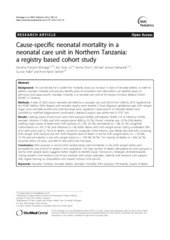| dc.description.abstract | Background: The current decline in under-five mortality shows an increase in share of neonatal deaths. In order to address neonatal mortality and possibly identify areas of prevention and intervention, we studied causes of admission and cause-specific neonatal mortality in a neonatal care unit at Kilimanjaro Christian Medical Centre (KCMC) in Tanzania. Methods: A total of 5033 inborn neonates admitted to a neonatal care unit (NCU) from 2000 to 2010 registered at the KCMC Medical Birth Registry and neonatal registry were studied. Clinical diagnosis, gestational age, birth weight, Apgar score and date at admission and discharge were registered. Cause-specific of neonatal deaths were classified by modified Wigglesworth classification. Statistical analysis was performed in SPSS 18.0. Results: Leading causes of admission were birth asphyxia (26.8%), prematurity (18.4%), risk of infection (16.9%), neonatal infection (15.4%), and birth weight above 4000 g (10.7%). Overall mortality was 10.7% (536 deaths). Leading single causes of death were birth asphyxia (n = 245, 45.7%), prematurity (n = 188, 35.1%), congenital malformations (n = 49, 9.1%), and infections (n = 46, 8.6%). Babies with birth weight below 2500 g constituted 29% of all admissions and 52.1% of all deaths. Except for congenital malformations, case fatality declined with increasing birth weight. Birth asphyxia was the most frequent cause of death in normal birth weight babies (n = 179/246, 73.1%) and prematurity in low birth weight babies (n = 178/188, 94.7%). The majority of deaths (n = 304, 56.7%) occurred within 24 hours, and 490 (91.4%) within the first week. Conclusions: Birth asphyxia in normal birth weight babies and prematurity in low birth weight babies each accounted for one third of all deaths in this population. The high number of deaths attributable to birth asphyxia in normal birth weight babies suggests further studies to identify causal mechanisms. Strategies directed towards making obstetric and newborn care timely available with proper antenatal, maternal and newborn care support with regular training on resuscitation skills would improve child survival. | en_US |

